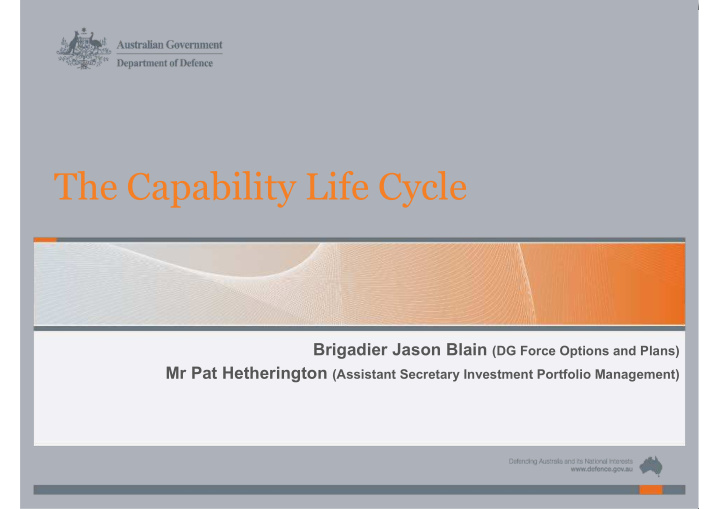



The Capability Life Cycle Brigadier Jason Blain (DG Force Options and Plans) Mr Pat Hetherington (Assistant Secretary Investment Portfolio Management)
Scope Two Parts 1. What is the Value Proposition of Defence to the Nation? 2. Overview of the new Capability Life Cycle
What is the Value Proposition of Defence to the Nation? The views expressed are those of the presenter, and should not be attributed to Defence
Australia's Strategic Defence Framework • Strategic Defence Interests: – Secure and resilient Australia – Secure near region – Stable Indo-Pacific and Rules based Global order
Value proposition of Defence to the Nation Another Strategic Interest? Australian Economic Prosperity
‘The Defence Budget delivers on the Government’s commitment to ensuring Australia’s long-term security and economic prosperity.’ Senator the Hon Marise Payne Minister for Defence
‘National security and economic prosperity are intrinsically linked.’ Hon Christopher Pyne Minister for Defence Industry
Value proposition of Defence to the Nation • Australian Industry Contribution • Dual use capabilities • Export driver – Building capacity • STEM investor
UK Defence Policy ‘The UK Defence industry has a unique value to our country, both vital to national security and a major contributor to our economic prosperity .’
UK MoD Policy • We will contribute to the UK’s economic security, support our industry including through innovation and exports, continue to invest in science and technology and contribute to wider skills and citizenship development that supports British society. • By investing in science, technology and innovation we are supporting the UK Industrial Strategy by contributing to a world leading UK research base that has a strong focus on commercial exploitation.
Questions I Leave You 1. Is it time that contributing to Australia’s Economic Prosperity becomes an explicit task for Defence? 2. What are your views on should, if and how this could be achieved? 3. Can this be achieved without compromising capability? jason.blain@defence.gov.au
Over to Pat
Key Design Components of the New CLC – WHAT IS DIFFERENT? The CLC is the end-to-end process for planning, developing, acquiring and maintaining Defence capability – major capital, infrastructure, Enterprise enablers and ICT. Key design components include: – More centralised direction – explicit alignment with strategic guidance – An ongoing Force Design process rather than episodic reviews – Strong arm’s-length Contestability – central to reducing the trust deficit – Earlier and better interaction external to Defence – Govt/Industry – Increased accountability for Capability Managers – Tailoring of project investment approval pathways (SmartBuyer) – Streamlined and reduced process and documentation – Strengthening the Program layer – Investment Committee oversight of the Integrated Investment Program
Capability Life Cycle Phases and Gates 6
The structure of the Investment Portfolio
Relationship with Government 6
Behaviours • Building and sustaining Government confidence in Defence as a policy advisor • Providing the best possible advice to Government to support good policy decision making • Empowering the Secretary and CDF as the key advisors to Government • Ensuring the best possible decision making by considering the full range of factors and influences on those decisions
Behaviours Ensuring that decisions are agile and adaptable to the environment in which they are made Ensuring that all stakeholders are engaged in a way that reflects their accountability Engagement with the Ministers and central agencies before and at Gate 0, so that they are aware of upcoming proposals
Behaviours • Business cases are developed in a manner that ensures they are understandable and scrutinised, minimises the use of jargon and provide the most accurate and timely advice Defence can prepare at the time; • Timely decisions are made at the appropriate delegated level when sufficient supporting information is available; and • Enabler and Delivery Groups focused on working closely with, and responsively to the Capability Manager to execute Programs with the optimum balance between capability, risk, cost and schedule.
Recommend
More recommend